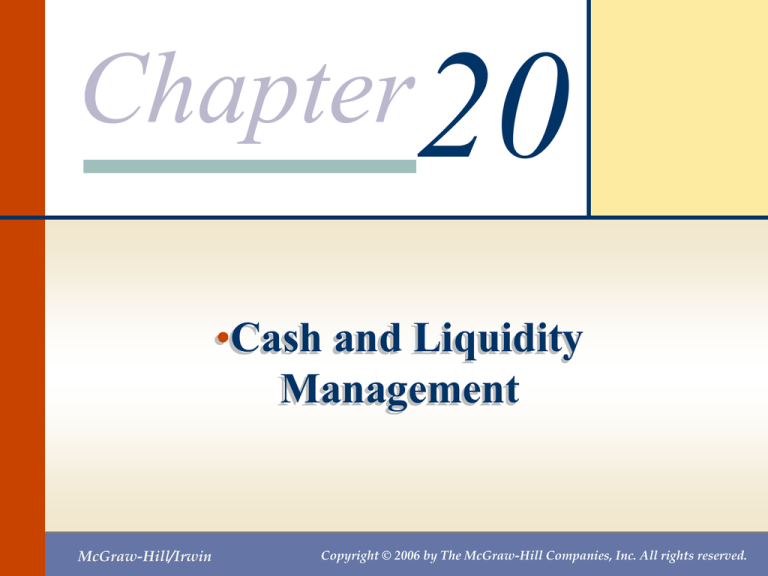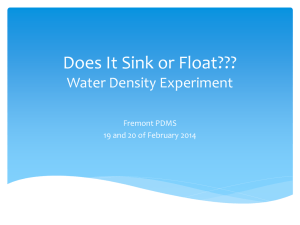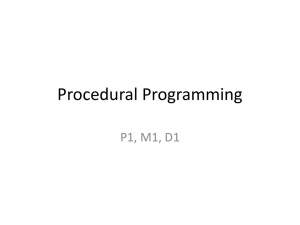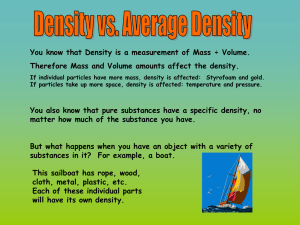
Chapter20
•Cash and Liquidity
Management
McGraw-Hill/Irwin
Copyright © 2006 by The McGraw-Hill Companies, Inc. All rights reserved.
Chapter 20 – Index of Sample
Problems
•
•
•
•
•
Slide # 02 - 09
Slide # 10 - 11
Slide # 12 - 16
Slide # 17 - 21
Slide # 22 - 25
Float
Cost of float
Lockbox net present value
BAT model
Miller-Orr model
2: Float
On an average day, your firm receives 50 checks. These checks, on
average, are worth $250 each. The average collection delay is 3
days. Also each day, your firm writes about 25 checks. These
checks are worth an average of $400 and clear your bank in an
average of 6 days.
What is the amount of the collection float?
What is the amount of the disbursement float?
What is the amount of the net float?
3: Float
Collectionfloat Firm's availablebalance- Firm's book balance
$0 (50 $250 3)
-$37,500
Disbursement float Firm's availablebalance- Firm's book balance
(25 $400 6) - $0
$60,000
Net float Collectionfloat Disbursement float
- $37,500 $60,000
$22,500
4: Float
Your firm has decided to contract with only three customers who
each pay you monthly as follows:
Customer
A
B
C
Check Amount
$60,000
$40,000
$50,000
What is the average daily float amount?
Collection delay
4 days
5 days
2 days
5: Float
Item Amount
Delay
Total float
$60,000
4
= $240,000
$40,000
5
= $200,000
$50,000
2
= $100,000
Total:
Averagedaily float
$540,000
T otalfloat $540,000
$18,000
T otaldays
30
6: Float
Your firm has decided to contract with only three customers who
each pay you monthly as follows:
Customer
A
B
C
Check Amount
$60,000
$40,000
$50,000
Collection delay
4 days
5 days
2 days
What is the amount of the average daily receipts?
What is the weighted average delay?
7: Float
T otalreceipts
Averagedaily receipts
T otaldays
$60,000 $40,000 $50,000
30
$150,000
30
$5,000
8: Float
Amount
Weight
Delay
Weighted
average delay
$ 60,000
60/150 = .4000
4
.400 4 = 1.6000
$ 40,000
40/150 = .2667
5
.2667 5 = 1.3335
$ 50,000
50/150 = .3333
2
.3333 2 = .6666
$150,000
1.000
Total = 3.6001
9: Float
Averagedaily float Averagedaily receipts Weightedaveragedelay
$5,000 3.6001
$18,000.50
$18,000
10: Cost of float
The Breadwinner Co. receives an average of $1,200 a day in
checks. The average delay in clearing is 4 days. Currently, the
applicable interest rate per day is .03%.
What the is the present value of the float?
What is the most this firm should pay to eliminate its collection
float entirely?
What is the highest daily fee this firm should pay to eliminate its
collection float entirely?
11: Cost of float
What the is the present value of the float?
PV of thefloat T otalfloat
Averagedaily receipts Averagedelay
$1,200 4
$4,800
12: Cost of float
What is the most this firm should pay to eliminate its
collection float entirely?
Maximumcost PV of thefloat $4,800
What is the highest daily fee this firm should pay to
eliminate its collection float entirely?
Maximumdaily fee T otalfloat Daily interestrate
$4,800 .0003
$1.44
13: Lockbox net present value
You are considering implementing a lockbox system and have
gathered this information:
Average daily lockbox payments
= 1,200
Average size of payment
= $750
Daily interest rate of Treasury bills
= .01%
Bank charge per check
= $.21
Reduction in mail time
= 1.5 days
Reduction in processing time
= 1.0 day
Reduction in clearing time
= .5 day
What is the NPV of this lockbox arrangement?
14: Lockbox net present value
NPV Averagedaily collections Reduction in delay (1,200 $750) (1.5 1 .5)
1,200 $.21
.0001
$900,000 3 $2,520,000
$2,700,000 $2,520,000
$180,000
See the next slide for another approach.
Daily cost
Daily interestrate
15: Lockbox net present value
Daily cost 1,200 $.21 $252
Daily savings 1,200 $750 (1.5 1 .5) .0001 $270
Daily profit $270- $252 $18
$18
NPV of daily profit
$180,000
.0001
See the next slide for a slightly different approach.
16: Lockbox
Daily cost 1,200 $.21 $252
$252
P V of daily cost
$2,520,000
.0001
Daily savings 1,200 $750 (1.5 1 .5) .0001 $270
$270
P V of daily savings
$2,700,000
.0001
NP V $2,700,000- $2,520,000 $180,000
17: BAT model
Your firm utilizes $165,000 a week to pay bills. The standard
deviation of these cash flows is $20,000. The fixed cost of
transferring funds is $48 a transfer. The applicable interest rate is
6%. The firm has established a lower cash balance limit of
$100,000. Answer these five questions using the BAT model:
What is the optimal initial cash balance?
What is the optimal average cash balance?
What is the opportunity cost of holding cash?
What is the trading cost of holding cash?
What is the total cost of holding cash?
18: BAT model
What is the optimal initial cash balance?
C*
( 2T F)
R
2 $165,000 52 $48
.06
$823,680,000
.06
$117,166.55
$117,167
19: BAT model
What is the optimal average cash balance?
C * $117 ,167
$58,583 .50 $58,584
2
2
What is the opportunity cost of holding cash?
$58,584 .06 $3,515.04 $3,515
20: BAT model
What is the trading cost of holding cash?
Optimalinitialcash balance $117,167
.7101weeks
Weeklycash need
$165,000
T otalweeks per year 52
73.229 T hisis thenumber of transfersper year.
Cash balanceduration .7101
Cost of transfer Number of transfersper year $48 73.229 $3,514.99 $3,515
21: BAT model
What is the total cost of holding cash?
T otalcost Opportunity cost T radingcost
$3,515 $3,515
$7,030
22: Miller-Orr model
Your firm utilizes $130,000 a week to pay bills. The standard
deviation of these cash flows is $15,000. The fixed cost of
transferring funds is $51 a transfer. Your firm has established a
lower cash balance limit of $80,000. The weekly interest rate is
.067%. Use the Miller-Orr model to answer these three questions.
What is the optimal initial cash balance?
What is the optimum upper limit?
What is the average cash balance?
23: Miller-Orr model
What is the optimal initial cash balance?
2 1 / 3
3
C* L F
R
4
2 .33333
3
$15,000
$80,000 $51
4
.
00067
$80,000 $23,417.26
$103,417.26
$103,417
24: Miller-Orr model
What is the optimum upper limit?
U* (3 C*) (2 L)
(3 $103,417) (2 $80,000)
$310,251 $160,000
$150,251
25: Miller-Orr model
What is the average cash balance?
(4 C*) - L
Averagecash balance
3
(4 $103,417) $80,000
3
$111,222.67
$111,223
Chapter20
•End of Chapter 20
McGraw-Hill/Irwin
Copyright © 2006 by The McGraw-Hill Companies, Inc. All rights reserved.










